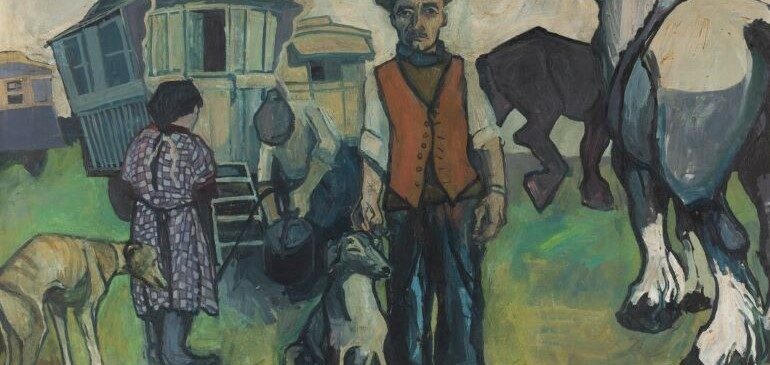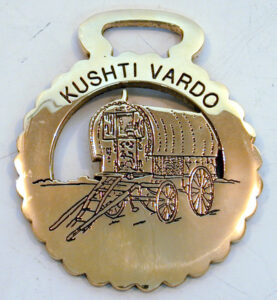The Power to Tell It for Ourselves
What exactly are Gypsy, Roma and Traveller things? How do they differ from things that belong to non-Gypsy, Roma and Traveller people? Most importantly, who decides?

Last summer, The MERL celebrated Gypsy, Roma and Traveller History Month (GRTHM) with ‘Roots and Routes’, a special reading and talk by award-winning poet Jo Clement. In this guest blog, they tell us about their recent panel at the Museums Association Conference in Gateshead, a workshop with local school children and some exciting collaborative changes afoot in our permanent exhibitions.
Being a poet is a pretty unique job. In the past few years, I’ve read to audiences from creaky leather couches on stages or teetering on the edge of blowy hilltops. If you’ve read my book, Outlandish, it might surprise you that most of the poems, in some way, started their lives in museums. From ancient teapots to eighteenth-century playing cards, I like to imagine the life objects lived before they were given a reference number and their place in the big glass case. I’m especially interested in how objects and artworks can represent different Gypsy, Roma and Traveller traditions that have passed through generations, especially those that have been lost to time.
Whether functional, beautiful, or both, museum objects are valuable touchstones to help distinguish and better understand the diverse identities and communities within the homogenous catchall ethnonym ‘Gypsy, Roma and Traveller’. Objects can prompt important questions. What exactly are Gypsy, Roma and Traveller things? How do they differ from things that belong to non-Gypsy, Roma and Traveller people? Most importantly, who decides?

Last year, I began to unpack these ideas with fellow ethnic Travellers Alex Barber and Damian Le Bas at The Museums Association Conference held in Gateshead’s Glasshouse. Our panel, ‘Invisible pasts, Invisible people?’, explored that just as Gypsy, Roma, and Travellers have been present for centuries in Britain, the tangible evidence of our cultural heritage is quietly present in the collections of many British museums today.
The ‘Equality, Diversity and the Creative Case’ report from Arts Council England (2017-18) found that only 12% of the workforce in their portfolio of museums and theatres were from black or minority ethnic backgrounds. Alongside this significant absence of museum workers who are ethnic Gypsy, Roma and Travellers, there is also a lack of expertise and knowledge among its existing staff. Uncatalogued, these unique histories remain undiscoverable and so untold.
Catalogued materials, however, present other challenges. Throughout my PhD research, completed in 2019, I discovered items incorrectly catalogued as pertaining to Gypsy, Roma and Traveller peoples. Whilst sifting through digitised catalogues, I discovered many holdings were categorised using racist, questionable or inappropriate language. The search ‘Romany’ produced scant findings, whereas misnomers, slurs or stereotypes would ping pages of results. Acquisition, cataloguing and display are vital matters of consent. Communities represented in collections must be consulted to ensure factual and ethical work is done. This should apply even to the keywords used to describe holdings. Respecting human dignity throughout this process is inseparable from the museum’s duty to educate.
The most powerful museums share a clarity of vision and values. They are connected indelibly to their place, their people or to a specific cause. Communities feel ownership of them, visitors feel welcome in them. All of us feel inspired or challenged by them.
-Gillian Findlay, Museums Association President
The MERL is doing powerful, future-facing work toward this end. Unlike many museums, it has a distinctive and permanent exhibition that shares knowledge and celebrates Gypsy, Roma and Traveller cultures and traditions. This year, I’m delighted to work closely with the team to help continue these brilliant efforts through investment in its redesign to incorporate some of the many objects and materials from the newly acquired Robert Dawson Romany Collection. I am also responding with an exciting new creative piece to be included in the display.
To celebrate this developing project, I recently welcomed local Gypsy, Roma and Traveller school children to The MERL. The morning kickstarted with a vibrant exploration around the museum as we hunted for objects. We sought things that looked familiar, heavy objects big or small, objects that we couldn’t live without and unfamiliar objects that taught us something new. This was the children’s first visit to the museum and they shared their vibrant perspectives on the exhibitions, particularly the animals, vehicles and tools.
Being outside was just as exciting as the exhibitions on show inside, as we met the MERL chickens and identified some of the plants on the fantastic Garden Trail. After some pizza and storytelling, we test-drove a new open-access educational resource I have designed for Key Stage 2 students to engage with The MERL’s handling collections. From catapults to leather shoes for lawn-mowing horses, I selected a range of objects to ignite and inspire young imaginations.
The children were inquisitive and interested, responding creatively with spirited ideas and expressive drawings, discovering new colourful characters and sharing stories. The day was a brilliant success, and I’m delighted with The MERL’s commitment to sharing not just Gypsy, Roma, and Traveller history but also contributing to a bright future.
